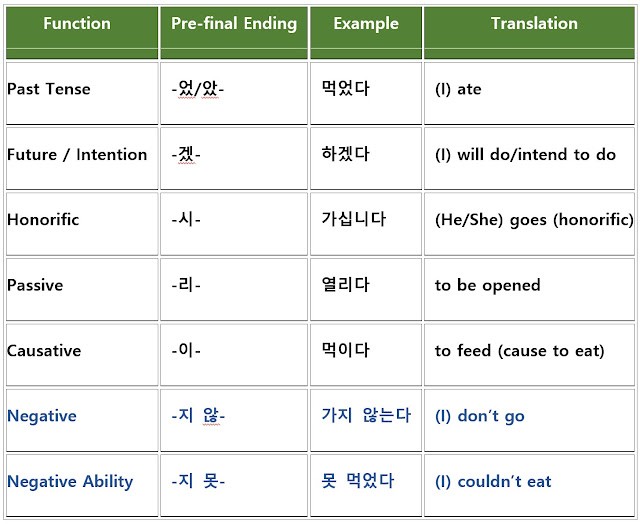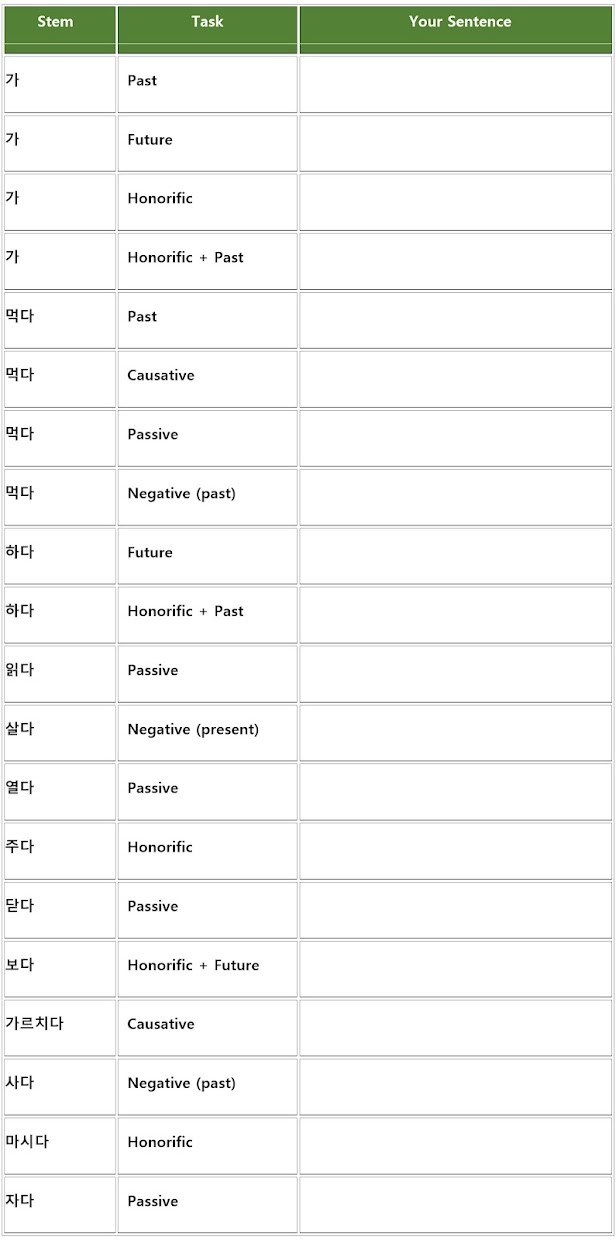TL;DR – Small endings, big meaning.
Korean verbs pack in tense, politeness, and nuance not by adding new words, but by inserting pre-final endings like -었-, -시-, -겠- between the stem and final ending.
They may be tiny, but without them, sentences fall flat.
Learn them, and you'll unlock natural Korean sentence flow.
Suppose you’ve ever wondered how Korean verbs manage to carry so much information—tense, formality, honorifics, and even voice—without adding extra words. In that case, the answer lies in a robust set of grammatical tools called Pre-final Endings (선어말어미).
Pre-final endings are morphemes that appear between the verb stem and the final ending. While small in appearance, they play a massive role in shaping the overall meaning and tone of a sentence. These endings are responsible for indicating past or future tense, showing respect to the listener or subject, expressing negation, or transforming the verb into passive or causative form.
This post continues where we left off in our previous guide on Final Endings (어말어미). Just like final endings determine the speaker’s attitude and sentence type, pre-final endings are essential for expressing nuance and clarity in Korean. Without them, a sentence may feel grammatically incomplete or emotionally off-key.
Let’s take a closer look at how these morphemes work:
1. What Are Pre-final Endings (선어말어미)?
Pre-final endings are grammatical elements that are inserted right after the verb or adjective stem and before the final ending. They change how the stem behaves or feels in a sentence.
They perform several essential functions:
– Tense: The ending “-았/었-” signals the past (e.g., “먹다” → “먹었다” = ate), while “-겠-” conveys future or intention (e.g., “가겠다” = I will go).
– Honorifics: The ending “-시-” adds respect toward the subject (e.g., “가시다” = [honorific] go).
– Negation: Though technically auxiliary verbs, “-지 않-” and “-지 못-” behave like pre-final endings (e.g., “가지 않는다” = does not go).
– Passive/Causative Voice: Endings like “-이-, -히-, -리-, -기-” (passive) or “-우-, -구-, -추-” (causative) often attach directly to stems, but semantically serve a pre-final function (e.g., “읽다” → “읽히다” = to be read, “먹다” → “먹이다” = to feed).
These endings act as linguistic bridges, carrying critical grammatical signals that reshape the verb before the sentence reaches its final form.
2. Sentence Structure Overview
The typical structure of a Korean sentence using pre-final endings looks like this:
Verb/Adjective Stem + Pre-final Ending + Final Ending
For example:
– “먹 + 었 + 다” → 먹었다 (ate)
– “가 + 시 + 었 + 어요” → 가셨어요 (He/She went [honorific + past + polite])
Without pre-final endings, it’s impossible to express when something happened or how the speaker feels about it. Compare:
– 가다 = to go
– 갔다 = went (past)
– 가겠다 = will go (future/intention)
– 가시다 = go (honorific)
– 안 간다 = do not go
🐾 “안 간다”: 이 문장에는 선어말 어미가 없습니다. “안”은 부정부사이고 “간다”의 “-ㄴ다”는 어말어미(종결어미)입니다. 다만, 비교하고 참고하라고 포함시켰습니다.
Each version tells a different story, with tense, tone, and respect all riding on the pre-final components.
3. Classification of Pre-final Endings
In Korean grammar, pre-final endings (선어말어미) appear between the verb or adjective stem and the final ending (어말어미). They carry essential grammatical meanings—tense, honorifics, negation, voice—and provide clarity on the speaker’s intention, time frame, and tone. Here’s a breakdown of the most common types:
3-1. Tense Markers (시제 어미)
These endings mark whether an action is happening in the past, future, or is intended.
– “-았/었/였-“(Past Tense): Adds past tense meaning
- 가→ 갔다 (went)
- 먹다→ 먹었다 (ate)
– “-겠-“(Future / Intention / Assumption): Mark’s intention, assumption, or future events
- 가겠다(will go)
- 알겠다(I get it / I understand)
3-2. Honorific Marker (높임 표현)
Used when showing respect to the subject of the sentence, often someone older or of higher status.
– “-시-“
- 가시다(go – honorific)
- 하셨다(did – honorific past)
- This marker elevates the subject, not the listener.
🧭 Who is honored?
The subject (not the speaker or listener) is being respected—usually teachers, elders, superiors.
3-3. Negative Markers (부정 표현)
Often functioning like pre-final endings but technically auxiliary verbs, they negate the verb or describe inability. It’s important to distinguish them from actual pre-final endings.
– “-지 않-“(negation)
- 가지 않는다(does not go)
– “-지 못-“(inability)
- 먹지 못했다(was not able to eat)
⚠️ Note:
Although these are not pre-final endings in strict morphological terms, they behave similarly by appearing between the verb stem and final ending. Thus, they are often taught alongside 선어말어미 for practical understanding.
3-4. Passive / Causative Markers (피동·사동 표현)
These markers attach directly to the verb stem, not after it, like true pre-final endings. However, they change the function or voice of the verb and serve a comparable grammatical role in meaning and nuance.
– Passive Voice: “-이-,” “-히-,” “-리-,” “-기-“
- 읽다→ 읽히다 (to be read)
- 열다→ 열리다 (to be opened)
– Causative Voice: “-이-,” “-우-,” “-구-,” “-추-“
- 먹다→ 먹이다 (to feed – cause to eat)
- 낮다→ 낮추다 (to lower – cause to become low)
✏️ Note:
While not true pre-final endings, these semantic transformations serve a pre-final function, affecting the meaning and grammatical role of the verb. Thus, they are treated here as “functional pre-final endings.”
📌 Key Examples

Q1. Are -았/었- and -겠- always pre-final endings? Q2. Why is -시- used even when the speaker is younger? Q3. Are -지 않- and -지 못- true pre-final endings?❓ FAQ (Frequently Asked Questions)
A1. Yes. They are tense markers that come between the stem and final ending, helping you express time and intention.
A2. It’s not about the speaker’s age—it shows respect to the subject of the sentence, often someone older or higher in status.
A3. Technically no, but they function similarly and are grouped with pre-final endings for practical learning purposes.
4. Practice Section
Combine the following verb stems with appropriate pre-final endings to create complete and natural Korean sentences. Practice both meaning and form.

5. Summary
– Pre-final endings (선어말어미) are essential for expressing tense, honorifics, negation, and voice (passive/causative).
– Though some elements (e.g., negative expressions or passive markers) are technically auxiliary verbs or suffixes, they function similarly and are crucial for sentence construction.
– For Korean learners, these structures often appear later in their studies, making repetitive and contextual practice highly beneficial.
What’s Next?
In the next post, we’ll explore Sentence-Final Endings (종결어미)—the elements that honestly complete a Korean sentence.
From –다, -요, -자, -니 to more nuanced endings, we’ll learn how to express intentions, ask questions, make suggestions, and more.
Korean endings go far beyond one post.
Each type of 어미 brings its own role—whether it finishes a sentence, connects ideas, adds formality, or transforms meaning.
This post is just one part of a broader journey.
Keep exploring the many kinds of Korean verb and adjective endings through the posts below.
▶ Practice Stems vs Endings
▶ Final Endings (어말어미)
▶ Pre-final Endings (선어말어미)
▶ Sentence-Final Endings (종결어미)
▶ Connective Endings (연결어미)
▶ Connective Endings: 100+ Quiz Questions
▶ Transformative Endings (전성어미)
#KoreanGrammar #Eomi #VerbEndings #LearnKorean #StudyKorean #KoreanLanguage #KoreanFluency #SentenceStructure #PolitenessLevels #LanguageTips
Appendix: Practice Answer Key & Explanations

Use this appendix to self-check and understand how endings are applied.


